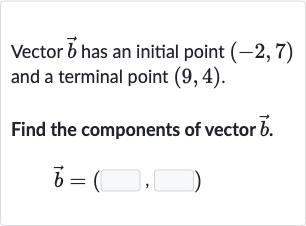AI tutor
Welcome to Bytelearn!
Let’s check out your problem:

Vector has an initial point and a terminal point .Find the components of vector .
Full solution
Q. Vector has an initial point and a terminal point .Find the components of vector .
- Identify initial and terminal points: Identify the initial and terminal points of the vector. The initial point of vector is , and the terminal point is . To find the components of the vector, we need to subtract the coordinates of the initial point from the coordinates of the terminal point.
- Calculate horizontal component: Calculate the horizontal component of the vector.The horizontal component is found by subtracting the -coordinate of the initial point from the -coordinate of the terminal point.Horizontal component =
- Calculate vertical component: Calculate the vertical component of the vector. The vertical component is found by subtracting the -coordinate of the initial point from the -coordinate of the terminal point. Vertical component =
- Combine components to form vector: Combine the horizontal and vertical components to form the vector components.The components of vector are (horizontal component, vertical component), which is .
More problems from Midpoint formula: find the midpoint
QuestionGet tutor help
QuestionGet tutor help
QuestionGet tutor help
QuestionGet tutor help
QuestionGet tutor help
